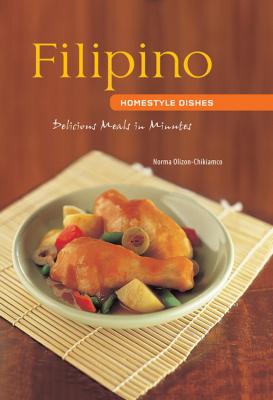ТОП просматриваемых книг сайта:
Filipino Homestyle Dishes. Norma Olizon-Chikiamco
Читать онлайн.Название Filipino Homestyle Dishes
Год выпуска 0
isbn 9781462905737
Автор произведения Norma Olizon-Chikiamco
Жанр Кулинария
Серия Learn To Cook Series
Издательство Ingram
Published by Periplus Editions (HK) Ltd.,
Copyright © 2004 Periplus Editions (HK) Ltd. All rights reserved. No part of this publication may be reproduced, stored in a retrieval system or transmitted in any form or by any means, electronic, mechanical, photocopying, recording or otherwise without the prior written permission of the publisher.
Recipes by Norma-Oiizon Chikiamco
Photography by A. Chester Ong
Food styling by Gina Navarro
Distributors
North America, Latin America and Europe
Tuttle Publishing, 364 Innovation Drive
North Clarendon, VT 05759-9436, U.S.A.
Tel: 1 (802) 773-8930; Fax: 1 (802) 773-6993
Asia Pacific
Berkeley Books Pte Ltd,
61 Tai Seng Avenue,#02-12,
Singapore 534167
Tel: (65) 6280 1330; Fax: (65) 6280 6290
ISBN: 978-1-4629-0573-7 (ebook)
Printed in Malaysia
15 14 13 12 11 12 11 10 9 8
Contents
| Introduction | 3 |
| Basic Filipino Ingredients | 4 |
| Dips and Condiments | 7 |
| Appetizers | 11 |
| Soups | 20 |
| Vegetables | 26 |
| Noodles | 32 |
| Rice | 40 |
| Seafood | 48 |
| Meat and Poultry | 57 |
| Desserts | 85 |
| Complete Recipe Listing | 96 |
MAIL ORDER SOURCES
Finding the ingredients for Asian home cooking has become very simple. Most supermarkets carry staples such as soy sauce, fresh ginger and fresh lemongrass. Almost every large metropolitan area has Asian markets serving the local population-just check your local business directory. With the Internet, exotic Asian ingredients and cooking utensils can be easily found online. The following list is a good starting point of online merchants offering a wide variety of goods and services.
http://www.asiafoods.com http://www.geocities.com/MadisonAvenue/8074/VarorE.html http://dmoz.org/Shopping/Food/Ethnic_and_Regional/Asian/ http://tern pleofthai.com/ http://www.orientalpantry.com/ http://www.zestyfoods.com/ http://www.thaigrocer.com/Merchant/index.htm http://asianwok.com/ http://pilipinomart.com/ http://www.ramarfoods.com/main.asp?p=home
Introduction
Filipino food is one of the least well-known of all Southeast Asian cuisines. Strongly influenced by the historical presence of the Spaniards, Chinese and Americans, it lacks the singular national identity that characterizes the food of other nations. Any mention of Filipino food would probably draw a blank from most people who can't associate it with any dish in particular. What is it? How does it taste? How does one cook it?
Yet it is precisely this indefinable quality, this veil of mystery surrounding it, that makes Filipino food an interesting discovery.
Imagine a stew of slowly tenderized beef, its sauce thickened by long, patient simmering, enriched with the flavors of olive oil and grated cheese. Or a pot of backyard vegetables cooked in shrimp paste and a spell of garlic, garnished with morsels of cubed pork. Or a parfait of tropical fruits and beans, sweetened with sugar and milk and topped with crushed ice. These, and more, are all part of the repertoire of the Filipino cook. They show the diversity of Filipino cuisine-from the Spanish-influenced Caldereta, to the indigenous Pinakbet, to the Asian-inspired Halo-halo melange.
This diversity is likewise reflected in the wide variety of ingredients used in Filipino cooking. While some dishes may call for the liberal application of Spanish olive oil, others are more Oriental in their use of Asian condiments such as soy sauce and shrimp paste. Moreover, not only are these condiments used during the cooking process; often they are also served at the table as dips, so that diners can customize the flavor of the dishes according to their own tastes.
Many Filipino dishes are also characterized by heavy sauces. While this may seem strange to some, to Filipinos it makes perfect sense. The sauces in a dish are often used to soften and flavor the rice with which the dish is eaten. Thus, dishes such as Stewed Pork (Estofado) are seldom served dry. These sauces are to Filipinos what gravy is to the Americans or Europeans.
With the advent of globalization, many Filipinos are now more aware of the cuisines of other countries. Modern appliances have also made cooking a much easier task than it was a century ago. Yet while hamburgers and pasta may sometimes be cooked in the contemporary Filipino kitchen, more often it is the standard Filipino dishes that rule. There will always be Adobo, Menudo and fish sauce, shrimp paste and soy sauce in a Filipino kitchen, whether it be in the urban climes of Manila or in the rugged terrain of Abra.
This collection of recipes presents

